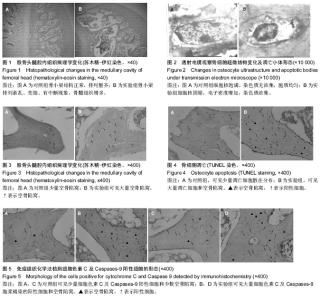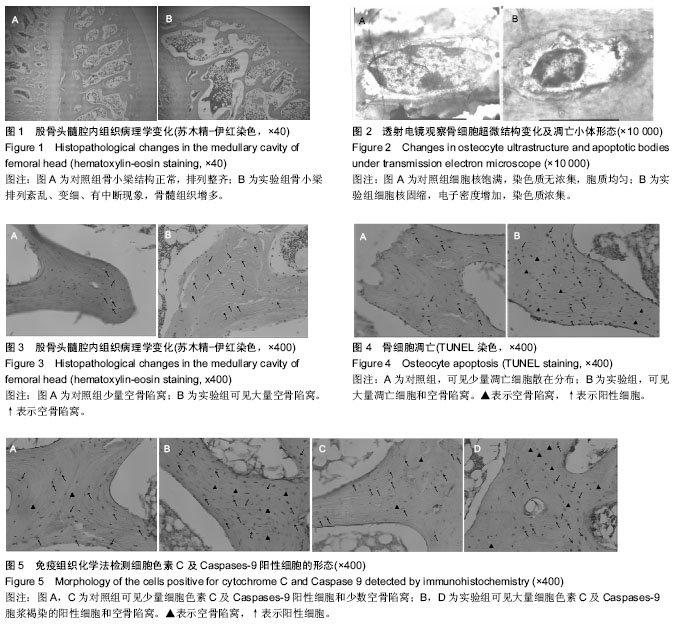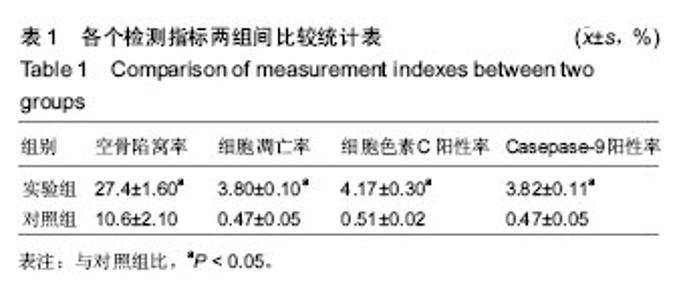| [1] |
Geng Qiudong, Ge Haiya, Wang Heming, Li Nan.
Role and mechanism of Guilu Erxianjiao in treatment of osteoarthritis based on network pharmacology
[J]. Chinese Journal of Tissue Engineering Research, 2021, 25(8): 1229-1236.
|
| [2] |
Pei Lili, Sun Guicai, Wang Di.
Salvianolic acid B inhibits oxidative damage of bone marrow mesenchymal stem cells and promotes differentiation into cardiomyocytes
[J]. Chinese Journal of Tissue Engineering Research, 2021, 25(7): 1032-1036.
|
| [3] |
Li Shibin, Lai Yu, Zhou Yi, Liao Jianzhao, Zhang Xiaoyun, Zhang Xuan.
Pathogenesis of hormonal osteonecrosis of the femoral head and the target effect of related signaling pathways
[J]. Chinese Journal of Tissue Engineering Research, 2021, 25(6): 935-941.
|
| [4] |
Xu Yinqin, Shi Hongmei, Wang Guangyi.
Effects of Tongbi prescription hot compress combined with acupuncture on mRNA expressions of apoptosis-related genes,Caspase-3 and Bcl-2, in degenerative intervertebral discs
[J]. Chinese Journal of Tissue Engineering Research, 2021, 25(5): 713-718.
|
| [5] |
Zhang Wenwen, Jin Songfeng, Zhao Guoliang, Gong Lihong.
Mechanism by which Wenban Decoction reduces homocysteine-induced apoptosis of myocardial microvascular endothelial cells in rats
[J]. Chinese Journal of Tissue Engineering Research, 2021, 25(5): 723-728.
|
| [6] |
Liu Qing, Wan Bijiang.
Effect of acupotomy therapy on the expression of Bcl-2/Bax in synovial tissue of collagen-induced arthritis rats
[J]. Chinese Journal of Tissue Engineering Research, 2021, 25(5): 729-734.
|
| [7] |
Xie Chongxin, Zhang Lei.
Comparison of knee degeneration after anterior cruciate ligament reconstruction with or without remnant preservation
[J]. Chinese Journal of Tissue Engineering Research, 2021, 25(5): 735-740.
|
| [8] |
Su Liping, Lu Ziyang, Liu Li, Zhang Wei, Su Tianyuan, Hu Xiayun, Pu Hongwei, Han Dengfeng.
C-jun, Cytc and Caspase-9 in the apoptosis of cerebellar granule neurons induced by diacetylmorphine in rats
[J]. Chinese Journal of Tissue Engineering Research, 2021, 25(25): 3943-3948.
|
| [9] |
Zuo Zhenkui, Han Jiarui, Ji Shuling, He Lulu.
Pretreatment with ginkgo biloba extract 50 alleviates radiation-induced acute intestinal injury in mice
[J]. Chinese Journal of Tissue Engineering Research, 2021, 25(23): 3666-3671.
|
| [10] |
Zhang Liang, Ma Xiaoyan, Wang Jiahong.
Regulatory mechanism of Shenshuai Yin on cell apoptosis in the kidney of chronic renal failure rats
[J]. Chinese Journal of Tissue Engineering Research, 2021, 25(23): 3672-3677.
|
| [11] |
Xie Yang, Lü Zhiyu, Zhang Shujiang, Long Ting, Li Zuoxiao.
Effects of recombinant adeno-associated virus mediated nerve growth factor gene transfection on oligodendrocyte apoptosis and myelination in experimental autoimmune encephalomyelitis mice
[J]. Chinese Journal of Tissue Engineering Research, 2021, 25(23): 3678-3683.
|
| [12] |
Xu Bin, Yang Xiushu, Liu Xuan, Wang Zhenxing.
Changes of intestinal epithelial cells and their apoptotic factors Caspase-3, Bax and Bcl-2 under urinary environment
[J]. Chinese Journal of Tissue Engineering Research, 2021, 25(20): 3173-3177.
|
| [13] |
Song Shilei, Chen Yueping, Zhang Xiaoyun, Li Shibin, Lai Yu, Zhou Yi.
Potential molecular mechanism of Wuling powder in treating osteoarthritis based on network pharmacology and molecular docking
[J]. Chinese Journal of Tissue Engineering Research, 2021, 25(20): 3185-3193.
|
| [14] |
Liu Kun, Xie Lin, Cao Jun, Ding Ning, Xu Lingbo, Ma Shengchao, Li Guizhong , Jiang Yideng, Lu Guanjun.
Increased FoxO1 DNA methylation level in homocysteine-induced podocyte apoptosis
[J]. Chinese Journal of Tissue Engineering Research, 2021, 25(2): 269-273.
|
| [15] |
Yan Xiurui, Tao Jin, Liang Xueyun.
Mechanism by which exosomes from human fetal placental mesenchymal stem cells protect lung epithelial cells against oxidative stress injury
[J]. Chinese Journal of Tissue Engineering Research, 2021, 25(19): 2994-2999.
|



